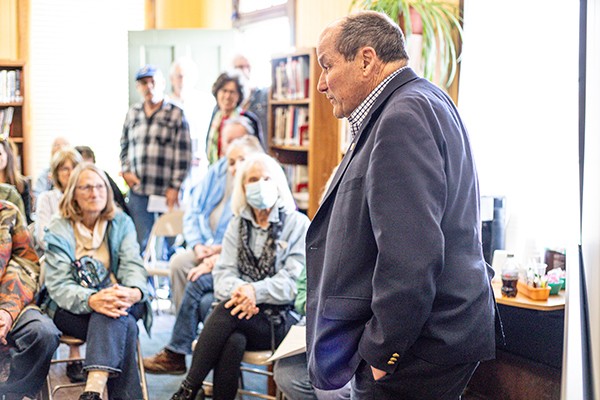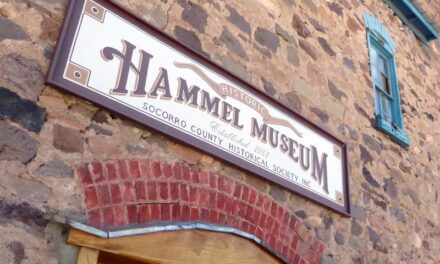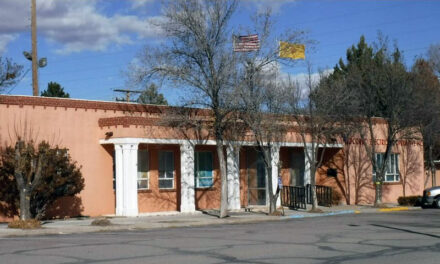Magdalena Public Library was at full capacity with more than 50 people in attendance for the San Agustin Plains hydrology and legal status presentation on Saturday.
“I am thrilled to see a crowd this big; it shows that the water grab has not been forgotten, even though it started in 2007 and dragged on and on,” Terri Winchester, event organizer, said. “It’s very shocking, if the thirty-five wells all run 24-hours a day, that’s 48 million gallons of water a day going out of that aquifer.”
The case of the San Augustine Plains Ranch LLC’s proposal to pump water out of the San Agustin Plains is in court once again. The educational event was prompted by the latest court hearing scheduled for April 5, where a series of legal motions will be heard at 10:30 a.m. at the 7th District Judicial Court in Reserve, by Judge Roscoe Woods.
Doug Meiklejohn, an attorney who has been involved with the case, offered the audience a recent history of the ongoing legal battle of the San Agustin Plains. He said in 2014, the San Augustine Plains Ranch LLC filed their second application to appropriate the 54,000 acres feet of ground water a year, which was denied by the state engineer. The San Augustine Plains LLC appealed the ruling to Judge Mathew Reynold’s district court. In a proceeding with Reynolds, he said, their appeal was denied, and they lost again.
Then in August 2019, The San Augustine Plains Ranch LLC appealed to the State Court of Appeals. He said three years later, “unfortunately and I think, incorrectly, the State Court of Appeals reversed Judge Reynolds’ decision.”
Meiklejohn said that he, the state engineer and parties on their side requested that the State Supreme Court review what the appeals court had done but they were denied a review.
He said case was sent back to the district court with Judge Reynolds, but he had unfortunately passed away in the interim. The case is now in front of Judge Roscoe Woods, and he doesn’t know anything about Judge Woods, so he has no idea what to expect.
“Judge Woods lives in Socorro and I think it’s important to show him that his community doesn’t want this thing to go forward. Your job at that hearing is to get as many people as possible there to demonstrate to the judge that this a very important matter for the community and that the community doesn’t want the Augustin Plains Ranch to be able to go ahead with what it proposes to do,” Meiklejohn said. “If you could get 100 people there that’s great, if you can get 200 people there, that’s better, and if you can get 300 people there that would be terrific.”
Meiklejohn told the audience that as a lawyer he had good news and bad news for them. The bad news is that the Court of Appeals overruled what Judge Reynolds did and the good news is that San Augustin Plains Ranch LLC was denied the evidentiary hearing that they claimed they were entitled to.
“I assume you all know that the person behind the Augustin Plains Ranch is an Italian millionaire, Bruno Modena; when I mentioned that to my son, he said ‘If you lived in Italy and you were looking for water, why would you come to New Mexico?’ But of course, he’s not looking for water, he is looking for money,” Meiklejohn said.
He said he saw several problems with the proposition to pump water including lack of end user, the 140-mile pipeline and the lack of evidence to support the plains producing that much water, “any notion anywhere in New Mexico, that the aquifers are infinite is just nuts.”
Dennis Inman, a Catron County resident who is a geologist and hydrologist, told the audience the watershed is a closed basin of almost 2,000 square miles in size. A closed basin means that all water that falls into the basin stays within the basin and there are no perennial streams in this basin. It is shared by two counties: Catron County, which covers approximately 1,551 square miles in size, and Socorro County, which is about 441 square miles in size.
“This is a really important part of this, how much can you actually take from the watershed, what is the limit?” Inman said. “What’s happened is because we are in a prolonged drought this system can’t keep up with what it’s leaking, in the past when there was a Lake San Agustin, the water table was much higher so the pressure in the system pushed a lot more water out. Now that it’s been used with the existing permits, the amount of water in the basin is a lot less now than it used to be, so if the LLC can pump out the water they want, it’s going to lower it even more and it could impact private wells.”
He said the ownership of the basin breaks down to 42% private owners, 25% state, 11% Bureau of Land Management and 22% Forest Service. San Augustin Plains Ranch LLC, included in the private owners, owns only 1.4%.
“The (San Augustin Plains Ranch) LLC has basically 18,000 acres, about 28 square miles, it’s 1.4 % of the basin and yet they want to control almost 99% of the water, that’s what would happen if this permit is allowed. Somebody that owns 1.4% would get control of all the water,” Inman said.
San Augustin Plains LLC drilled an exploratory well south of US 60 to a depth of 3,500 feet and they encountered fine sand, silt and clay only, with no groundwater. Then they drilled another well about 2 miles north of US 60 to a depth 1,510 feet and hit groundwater at 510 feet. They performed a nine-day pump test that yielded 2,000 gallons per minute, which caused the water table to drop 87 feet.
Inman said another concern was that excessive extraction could cause settlement that would create tension cracks that could lead to costly damage to existing infrastructures, like roads, houses, gas lines, and water lines.
“The water is actually holding a lot of sediment in suspension, there is enough friction between the water and surrounding particles to hold them apart; if you pump too much water, those start to break down and they become a lot more suspectable to causing fracture systems to occur almost on to the surface in some places on the land and causes major problems,” Inman said.
After the presentation, attendees were able to talk, ask questions and meet Inman and Meiklejohn. A video of the presentation will be available at the Magdalena Public Library.






















